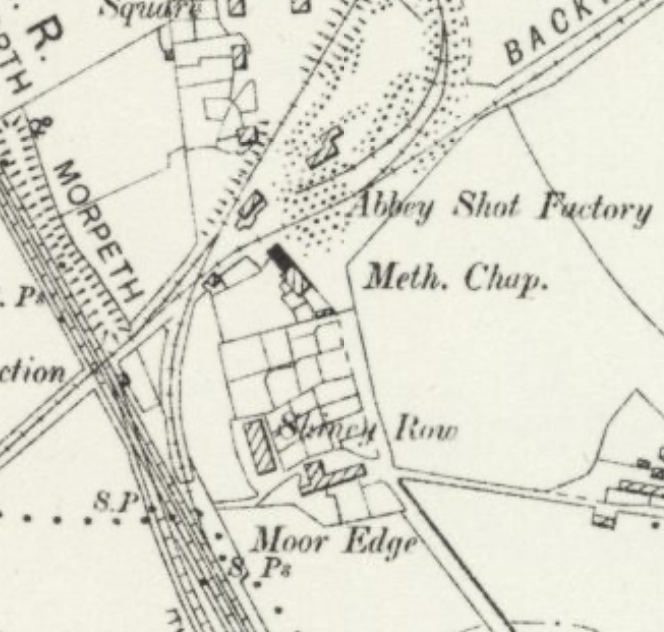Walk : 27th February : 6pm
Meeting beside Sambuca on Benton Road, NE27 OP (W3W edits.prowling.combines)
walking to Shiremoor, NE27 SD, (W3W obstinate.tributes.stroke). Approx 2.4 miles 50mins
round trip.
Journeying God, of the lost things
As we look for the ‘place’ Wander with us.
When we take a break, when we rest for a while,
when we sleep and dream.
In those moments may love be revealed.
May we wake,
to mark the moment, the place
where you met us.
Amen
We find Jacob on a journey from one place to another. The starting point and destination don’t matter too much. It is the place where he stops that is our focus today.
The place was a ‘certain place!’ Not an important one or a specific one. He wasn’t looking for this place. It was just a place he stopped at on his journey when the sun went down and he needed to rest.
He found a rock for a pillow and promptly fell into a deep and dream-filled sleep. In this dream he saw a stairway to heaven and he heard God speak to him about his future and the future of his descendants. When he awoke he exclaimed ‘Surely the Lord is in this place, and I was not aware of it.’ He then states that this stopping place, this unlooked for place was none other than the house of God, the doorway to heaven. He takes his makeshift pillow and stands it up to mark the place as important, and he names it Bethel which means House of God.
The places we look at this week in Shiremoor, The Allotment and New York all contained Methodist Chapels at some point in the past. You may see a glimpse of one building that still stands tucked behind a pub in The Allotment but the others have all been demolished and built over. When most of these chapels were built there was very little around them. The big industry in the area was the mines dotted around the countryside that needed workers, who in turn needed places to live, shop, socialise and pray.
The earliest chapel mentioned in records is The Allotment Primitive Chapel built in 1832. In fact it would have celebrated its 191st birthday on this first Sunday in Lent as it opened on the 26th February in 1832. It is thought the chapel sat in a small building about 18ft by 30ft built by a T Taylor at no cost and was part of a square of mining cottages. It had 43 members and there was no other church close by. They wanted to start a Sunday School up as soon as they could.
In 1868 we know that a new chapel was created nearby to the first site in a brewery building. This building was converted by an R Prudhoe along with others into the chapel. The building still stands today and if you park in the Sambucca Restaurant car park you will see it. This building only lasted 37 years as a chapel, and when it closed was used as a community centre for the growing village for a short while. A new building was built in 1904 which seated 70 people and lasted until 1998 when it closed.
Up the road in Shiremoor there are records of two chapels. One was situated right next to Earsdon Colliery and is noted as a United Free Methodist Church (some note it as a Wesleyan Reform). It lasted around 36 years and little else is known of it. Further into Shiremoor we find Percy Street Primitive Methodist, built in 1904 for £760 and seating 120 people.
The obituary for the Revd Walter William Parsons notes ‘In 1921 Rev Parsons was sent to the Earsdon Church, in the North Shields Circuit, as their first resident minister. He was there at the time of the miners’ strike, and remembered vividly the great spiritual awakening in that area, as a result of the prayer meetings held in the Shiremoor Chapel.’
Percy Street lasted until at least 1939 and maybe a little longer until it was demolished to build the housing estate that sits on the site today.
Finally, New York United Methodist Church sat on Coronation Terrace from 1902-1957. It is noted that they moved to Chirton Grange Methodist from this site and the building was demolished.
The story of these early Methodist Chapels is one of need. As people moved to purpose-built houses that served the mines and farms in the area they also needed other amenities; pubs, shops and places to gather and worship.
Jacob wasn’t looking for the House of God when on his journey from one place to another. He just discovered that God was in that certain place. Likewise, the people who built and gathered in these places weren’t looking to set up places of worship. Instead they experienced God at work in the world and in turn responded. The chapels were the outworking of God’s grace at work in the hearts of human beings.
Questions to reflect on
1.Where is your favourite place in the world?
2.Where is your favourite place to meet with God?
3.Do you think it mattered where Jacob stopped that day?
Would God have appeared to him anywhere or did it have
to be that specific spot?
4.Is there a certain place you have met God that was out of
the ordinary?
5.Which certain places might God be asking you to respond
in today? Your street, community, work place?
6.If you were to build a chapel today to meet a need in your community, where would it be and why?
Has been a part of BeachcomberFX since his arrival in the North East in 2014. He is well travelled (at least in the UK) having lived in Manchester, Nottingham, Derbyshire, Southport, Doncaster, Berwick and Edinburgh. Supporter of Newcastle United, will watch any sport.
